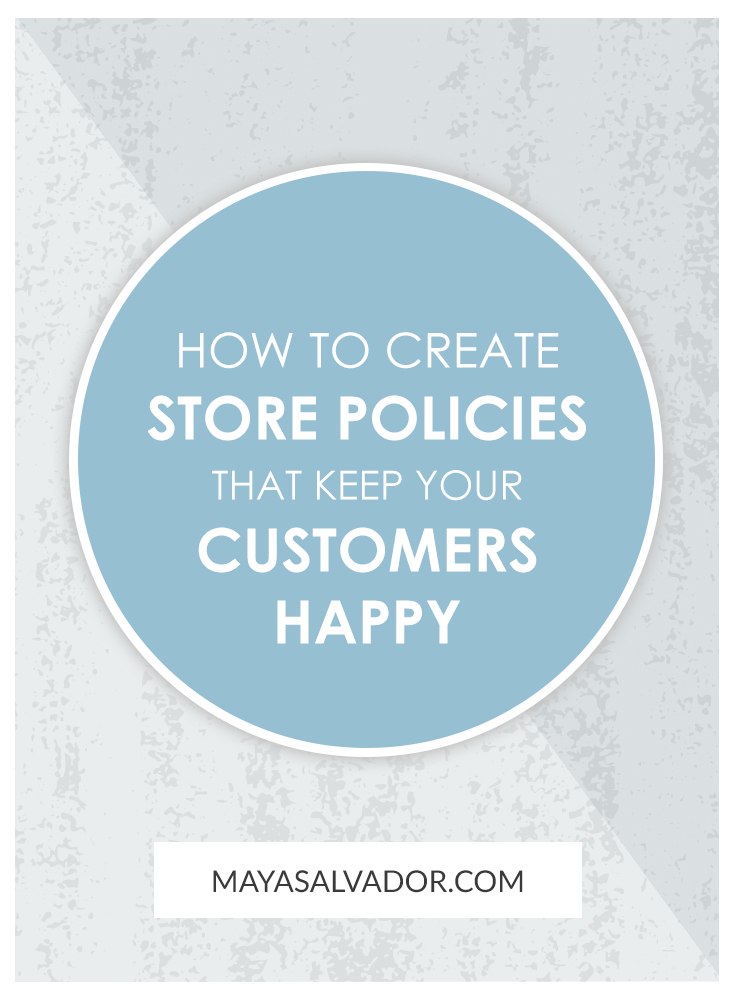
Many of us who have Etsy, EBay or other online storefronts often overlook the importance of having well-crafted store policies that are clearly listed.
According to Invesp, which surveyed more than 200 e-commerce websites, only 57% of retail sites have a clear return policy. Only 38% of retail sites provide estimated delivery times to their clients. They found that 64% allow guest checkout.
Customer experience is key to sales performance
Writing a store policy protects you and your customer from any disagreements that may occur due to a lack of communication.
Making the rules of your store clear and to the point will help your business run more smoothly. And it will help you achieve a positive customer experience. Writing your store policies doesn’t have to be hard. It’s a great way to let everyone that visits your shop know what the rules are.
The 11 key ingredients to making a great store policy
Your store policy may vary (e.g. you may offer custom orders), but here are some of the more common parts to a store policy that should get you started.
1. Your welcome message
The best way to write a welcome statement is to introduce your shop. Tell a little about the products you offer and say hello to your potential customers. Keep this section short and sweet.
2. Your payment methods policy
Let customers know right away which forms of payment you accept. If you are accepting PayPal payments, please remember to let your customers know that they don’t need a PayPal account to purchase items from your store. Credit and debit card holders can use PayPal to check out as a guest.
Make the buyer aware of any transaction fees they may incur, if applicable.
Do you accept orders by telephone?
If you don’t process orders until payment is cleared, be sure to state this as well. If you accept deposits or payment plans, then outline these details.
Be sure to add your policy regarding non-payment.
3. Your production and processing times
How long does it take for you to create or prepare your item before shipping? Write in how many business days it takes on average for production time.
Remember, it’s always better to overestimate than underestimate.
Keep in mind extra time during busy seasons and custom orders (if this applies to you). State in your policy that delays may be unavoidable due to back orders or item availability.
It’s a good idea to post a deadline schedule for busy seasons and list cut-off dates (e.g. Christmas, Mother’s Day). If the purchase is time sensitive (e.g. buyer needs it for a wedding or birthday), include this too. Ask the customer to send you any deadlines if appropriate.
4. Your shipping & packing policy
How long?
State how many business days customers can expect before their order is shipped. This will avoid complaints with shipping expectations.
Where to?
Also, list where you ship to. If you only ship within the Unites States, let customers know.
Can I get my order faster?
Allowing customers to add insurance or choose faster shipping options is a great idea to include.
Can I send a gift?
If you offer gift wrapping as an option, include this in your statement as well.
How do you prevent damage?
Let your customers know that you take measures to protect their item during shipping. This could be by using protective film or bubble wrap. This shows your customer that you have taken great care to secure their purchase.
Are there extra fees?
No one likes hidden fees or surprises. Make your customers aware of any taxes and/or duties that may be added to their order.
5. Your refunds and exchanges policy
A refund policy allows customers to return damaged or unwanted items. Outline the restrictions and time limitations of your policy.
Do you offer refunds on pre-ordered or limited edition items?
In some cases, you may not wish to issue refunds or exchanges (e.g. PDF or other digital downloads) so make sure to clearly state that in this section of your policy.
But, if you do accept refunds, state how many days you are willing to accept returns. Most shops have a 30-day return policy, but don’t be afraid to extend your return policy for as long as you can.
Extending your return policy gives customers the peace of mind to place an order. Most of your customers will not act on your return policy – they just like to know it’s there.
Also, consider offering store credit instead of a cash refund.
Go the extra step and have your refund policy also visible on the cart page of your online store. A lot of times buyers won’t look up your refund and exchange policy until after they need it. Making your policy as prominent as possible minimizes miscommunication with returns.
6. Sizing and product descriptions
Speaking of refunds and exchanges, the best course of action is to prevent them in the first place. Include sizing and/or colour charts (if applicable).
In addition to a text chart, you can create a graphic image of the chart and include this with your product images.
To avoid confusion you can include both imperial and metric conversions for measurements.
Draft clear product descriptions. Make the text scannable and easy-to-read by using bullets and breaking up paragraphs.
Create accurate and professional product photography and videos. Show your products in use or on models. Show the scale, quality and colour of your products to avoid disappointment. Include detail shots as well.
7. Your FAQ or frequently asked questions section
This is the perfect place to answer any questions that past customers have asked you about your store and its policies.
This can be a list of the top 20 questions you have answered. Your shop’s FAQ may help future customers navigate your shop better.
Invite your shoppers to leave feedback. Listen and respond to your customers. Engaging with your customers will improve your brand and customer experience.
8. Communication
Let your customers know how and when they can get in touch with you and when can they expect a response.
Again, you want to over-deliver on your customer’s expectations. You could write in your statement that you will respond to inquiries within 24 hours. Avoid a longer wait time than this. But do your best to get back to customers sooner.
Even better if your online store can offer live assistance via chat. The more ways your customer can contact you, the better.
Let your shoppers know how they can track their order once they have placed it. Do customers have to sign up for an account or do allow guest checkouts?
Do you send an order receipt as well as a shipping notification with tracking?
Consider sending a thank-you or follow-up email to ensure customer satisfaction.
Make sure you continue to communicate with your customer after they have placed an order.
9. Terms of Use
Depending on what you are selling, you may need a Terms of Use policy.
Are you a photographer, illustrator, graphic designer or other creative? Artists, in particular, need to include their product usage policy.
This may mean stating that the buyer cannot modify, resell or distribute your work.
Do you accept personal and commercial use? Will you include the option for licensing? Do you have warranties or limitations of liability on your products?
Think about your end product usage and state your requirements.
10. Privacy Policy & Terms and Conditions
Transparency is necessary to protect your site, business, and customers. Do not skip on your privacy or terms and conditions policies.
You need to comply with your local laws by providing both on your website.
Be sure to use clear and simple language. Privacy assurances encourage customer trust.
If you can’t get these drafted by a lawyer, there are other options. There are several online policy generators available to get you started. You will find a few linked near the end of this article.
11. Security
Another important element to convey to your website visitors is security. Fraud and identity theft is a huge concern.
If you have a self-hosted site handling transactions, then you need an SSL certificate. A Secure Sockets Layer (SSL) certificate protects data through encryption. This is necessary if you collect personal information or credit card numbers.
An SSL is also used for site validation. This verifies the business behind the website. An SSL certificate is essential to create public trust.
If you’re using a third-party platform like Shopify then you don’t need to worry about an SSL. Another plus is that you don’t have to worry about site hosting, security and data protection. It’s all included.
You can also include any industry organizations you belong to. If you are a verified business through the Better Business Bureau, include this too.
Testimonials and ratings from verified buyers also create trust. Do everything you can to protect your customers and communicate that you are a trusted seller.

More Tips
- Use clear and simple wording. Keep it friendly!
- Once you have finished writing your store policy it’s wise to run it through a spell checker program. Also, ask a friend or family member to read it to make sure it makes sense to them before posting it on your storefront. An extra pair of eyes is a great way to catch mistakes and correct them before going live.
- List all conditions and be up front about them.
- When problems arise, fix them.
- Overestimate when writing time expectations into your store policy. Deliver more than your customers expect. For example, if your store policy states 3-5 business days before you ship orders, ship it in less time.
- Make sure your policies are easy to find. Use every opportunity to display them (e.g. at checkout).
- Review your policies every so often and look for areas that may need revision. Outdated policies can cause issues. It also helps to include the date of when your policy was last updated.
Where to start
Not sure where to begin or what to write? Confused by the legalese of privacy and terms and conditions policies?
Look at the store policies of other sites, in particular, stores that are like yours. This will offer ideas for what you should include on your store’s website.
Here are some store policy templates from Shopify to get you started:
If you are using Printful for your product printing and fulfillment, they have ready-made policies for you to use:
Having a store policy for your online store is vital to your business
Problems usually arise when there is a disconnect between expectation and reality. The main function of your store policy is to anticipate and answer to those expectations.
Make customer service part of your brand and deliver the best experience for your customers.
Do your store policies need work? What lessons did you learn that caused you to revise them? Or, what do you think is missing from this list?
Share your experiences in the comments below!







